#buddha water fountain
Explore tagged Tumblr posts
Text




39 Inch Granite Fountain With 2 Feet Marble Buddha Idol For Contemporary Decor
#home and garden#decor#decoration#handcrafted#home interior#interior decorating#interior#interior design#interiors#exterior design#contemporary decor#minimalist decor#buddha fountain#buddha water fountain#buddha water feature#home decor#garden decor
0 notes
Text
My Aashis is a highly anticipated online store. We offer a broad range of high-quality and ethically sourced products, including jewelry, home decorations, and contemporary furniture.
We are committed to providing our customers with the best shopping experience, and we promise that you will be able to find everything you desire in our store.
Please don't hesitate to write us if you get any questions or comments about myaashis. Buy Modern decor piece
#luxury dining table#shop for cheap wall clocks#buy wall clock online#buddha water fountain#fengshui water fountain#ganesh water fountain#ganesha water fountain#indoor water fountain#marble dining table#marble dining table and 6 chairs
0 notes
Text
Hey folks,
In this article, we are going to discuss our Lord buddha water fountain. So I hope you'll enjoy it.
Kindly check out our blog and give your comments and feedback.
#buddha#buddha fountain#buddha water fountain#water fountain#indoor water fountain#outdoor water fountain
1 note
·
View note
Text
Stop
Look
Listen
Feel
Relax
Refresh
This video was shot at a temple in Chiang Mai, Thailand
#video#spilled thoughts#spilled ink#spilled words#water#fountain#statue#statues#sculpture#buddha#buddhism#buddhist#art#outdoors#spirituality#relaxation#relaxandenjoy#relaxandunwind#thailand#chiangmai#words#my words#words words words#contemplation#contemplative#contemplating life#contemplación#just contemplating#prose poem#poem
7 notes
·
View notes
Text

0 notes
Text
Elevate the ambiance of your home with Ganesh Moorti Art's exquisite Buddha Marble Statue Water Fountain. Crafted with precision and artistry, this fountain infuses tranquility and elegance into any space. With its serene design and soothing water flow, it creates a harmonious atmosphere, inviting relaxation and peace. Let our fountain be the centerpiece of your home, bringing a touch of serenity and beauty to your surroundings.
0 notes
Text
Atlanta Patio Pergola

Ideas for a massive, rustic backyard stone patio fountain renovation that includes a pergola
0 notes
Text
Atlanta Patio Pergola

Ideas for a massive, rustic backyard stone patio fountain renovation that includes a pergola
0 notes
Text
Atlanta Patio Pergola

Ideas for a massive, rustic backyard stone patio fountain renovation that includes a pergola
0 notes
Text
Atlanta Patio Pergola

Ideas for a massive, rustic backyard stone patio fountain renovation that includes a pergola
0 notes
Photo

0 notes
Text


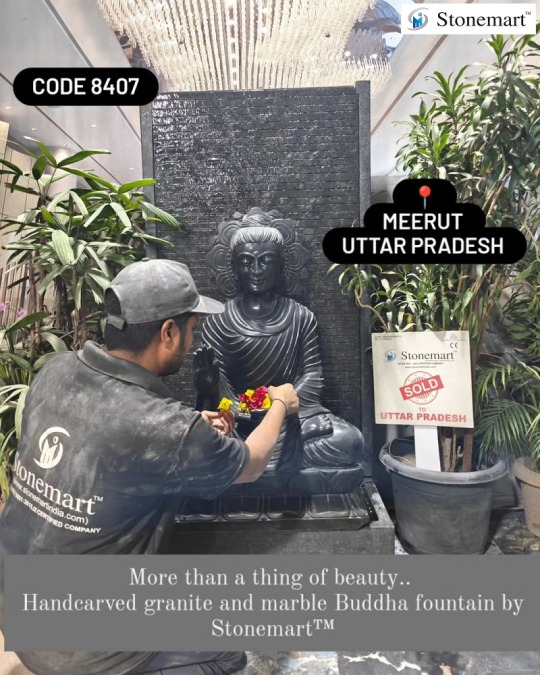
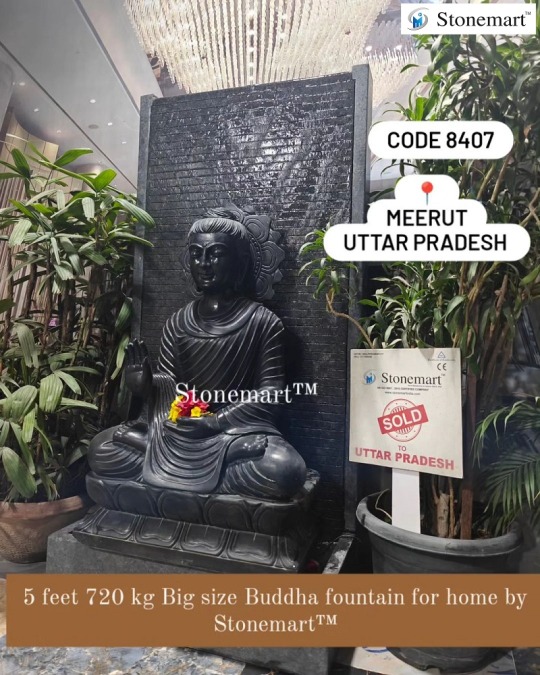
Handcrafted 5 Feet Big Granite Stone Water Fountain With 3 Feet Marble Stone Buddha Idol
#home and garden#decor#decoration#handcrafted#home interior#interior#interior decorating#interior design#interiors#exterior design#home decor#garden decor#hand made#buddha water fountain#buddha fountain#buddha waterfall#living room decor#patio decor#balcony decor#interior decor#exterior decor
0 notes
Text
Finding Tranquility : The Harmony of Buddha Water Fountains and Crystal Chandeliers
In the pursuit of inner peace and aesthetic charm, the fusion of Buddha water fountains and crystal chandeliers presents a captivating juxtaposition. These elements, each embodying unique symbolism and allure, come together to create spaces that inspire serenity and elegance.
Let's delve into the synergy between these timeless accents and explore how they can transform any environment into an oasis of tranquility.
instagram
The Symbolism of Buddha Water Fountains
Buddha water fountains serve as more than just decorative pieces; they symbolize tranquility, enlightenment, and the flow of positive energy.
Here's how :
Flowing Water
Represents the continuous flow of life and the cleansing of negative energy.
Buddha Figurines
Signify serenity, mindfulness, and spiritual awakening.
Zen Aesthetics
Infuse spaces with a sense of calmness and balance, promoting relaxation and introspection.
The Elegance of Crystal Chandeliers
Crystal chandeliers exude opulence and sophistication while casting a mesmerizing glow that elevates any ambiance.
Consider the following:
Dazzling Brilliance
Reflects light in a myriad of colors, creating a captivating visual spectacle.
Timeless Appeal
Adds a touch of luxury and refinement, enhancing the overall aesthetic of a room.
Focal Point
Commands attention and becomes a conversation piece, drawing admiration from all who behold it.
Harmonizing Elements : Bringing Buddha Water Fountains and Crystal Chandeliers Together
The convergence of Buddha water fountains and crystal chandeliers creates a harmonious synergy that enhances both their individual charms. Here's how they complement each other:
Contrast and Balance
The tranquility of the Buddha fountain offsets the grandeur of the chandelier, creating a harmonious equilibrium.
Sensory Experience
The gentle sound of flowing water combines with the shimmering light of the chandelier to engage multiple senses, inducing a state of relaxation and wonder.
Spiritual Elevation
The presence of Buddha imagery alongside the elegance of crystal symbolizes a union of earthly and spiritual realms, fostering a sense of connection and enlightenment.
Embracing Serenity : Transforming Spaces with Buddha Water Fountains and Crystal Chandeliers
Incorporating Buddha water fountains and crystal chandeliers into interior design schemes allows individuals to curate environments that promote serenity and sophistication. Whether in homes, offices, or meditation spaces, their presence inspires peace and beauty, reminding us to seek balance amidst life's chaos.
Conclusion
Buddha water fountains and crystal chandeliers transcend mere decor; they embody the essence of tranquility and elegance. Together, they create spaces that not only delight the senses but also nourish the soul, inviting us to embrace harmony and serenity in our daily lives.
#Buddha water fountain#Buddha fountain#Sai water fountain#Radhay krishna water fountain#Ganesh water fountain#Ganesha water fountain#Fengshui water fountain#Shiv water fountain#Indoor water fountain#Water fountain#Instagram
0 notes
Text
Toman and Buddhism + Tenjiku and Taoism
Another post to cover references in Tokyo Revengers!
This time, I'll be covering the links to two religions to be found in two gangs in the series, reference by reference, with the according explanation of each.
Some of these may be already known, I know one of them sure is (the whole buddhist manji confusion thing yeah yeah) but still, for the sake of a tidy compilation and of providing more detail, I'll go through them too. Some others are a lot less noticed, like Tenjiku's lean towards Tao, so it'll be best to lay down eeeeeeverything I've caught during my time enjoying this series. Plus, I'm pretty excited to get some of those less-known facts out here!!
Warning though, it's lengthy.
Let's start with Tokyo Manji Gang:
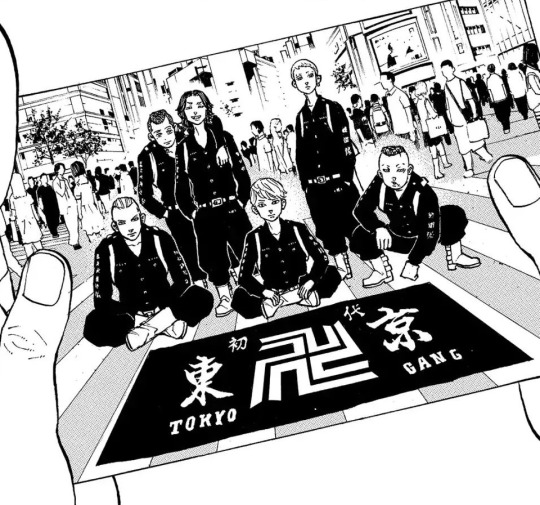
- Firstly, the gang's name and how it's written.
Despite Mikey suggesting the name as a short form of Tokyo Manjiro Gang, putting himself front and center, the kanji that ended up forming the name of Tokyo Manji Gang show that it went in a different direction of meaning. The manji used for the middle part ended up not being the same one from the name Manjiro, but a manji written as 卍. Aloud it's read the same way (many, many, many kanji are homophones), but has a different meaning.
卍 (manji) is an extremely common buddhist symbol (not even limited to japanese buddhism, but in hinduism and other aligned east-asian religions too), which represents the path of Buddha and the endless cycle of rebirth through samsara; the pursuit of leading a more spiritually balanced existence until the soul can reach enlightenment. In other words, it's nothing but deeply buddhist.
(To answer a common question around it: can it be called a swastika? Yes. The symbol in general, with each of the million variations that have popped up in different cultures, can be called a swastika as a broad term. There are a fuckton of swastikas. They mean a fuckton of different things. The tilt and the direction in which this one "spins" makes it different from other swastikas though, and it's always best to be precise and call this one manji.)
Moving on,
- Reunion spot.


The Musashi Shrine (based, but not exactly taken from any of the real-life shrines and temples of similar name in Tokyo, as far as I know) is a shinto-buddhist temple. And, apparently, a place where the founders hung out from time to time, but I'll add to that later!!
It's cute to me that the Toman members seem to use the temple very respectfully. They always meet in it at night waaay after it's closed (daytime meetings have always taken place in different locations, never the temple during visiting hours), they've never once set foot even near the oratory/sanctum/other buildings, never been seen bringing the motorcycles anywhere they shouldn't, and the one time a character was seen using the public temizuya (the little stone fountain where visitors purify their hands and mouth), he was proper about it in terms of pouring water into his hand to rinse his mouth with, not getting the ladle or the rest of the water dirty, as one should always do.
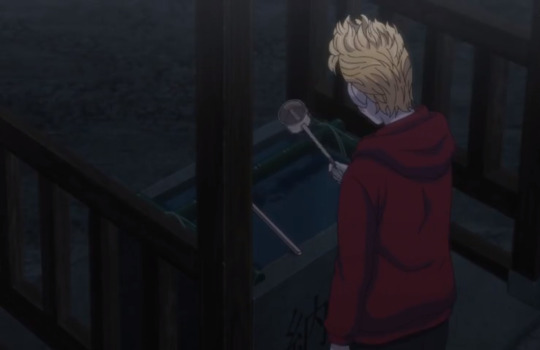
A fun fact: in Google Maps, buddhist temples are marked with the manji symbol!
- Gang's manifesto.

Embroidered on the chest of the gang uniform, you can see the text 天上天下唯我独尊 ("Above the earth and below the heavens, I alone shall be honored"), which is the gang's manifesto or motto. Sounds just like something Mikey would choose, yeah.
That phrase is also of buddhist origin; famously, the words spoken by Buddha Gautama Siddharta (bear in mind that buddhism isn't a religion with one god or anything like that, anyone enlightened can become a Buddha and many figures have been granted that status, but Gautama is the first and main one, the creator of the doctrine) when he was born. To be honest, this is very much interpretative, but I've come to get the impression that it's not so much a power or ego statement, but rather an expression of cultivating and honoring yourself…? It's absolutely up to personal reading and I'm absolutely not an expert. But those are certainly THE Buddha's words.
- Ceremonial sash.
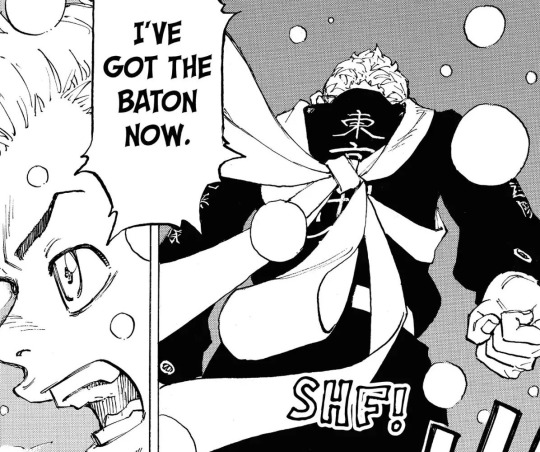
Another part of their uniform that bears a slight reference: the sash worn by the commander, vice-commander, captains and vice-captains during important fights.
These are tasuki, sashes originally worn by shinto-buddhist priests during ceremonies, in order to keep long sleeves and such in place. However, eventually, they also began being worn by samurai and all sorts of warriors, 'cause of their convenience. In modern times, they even started being used by just about anybody who wears traditional clothing but also does manual work and needs the sleeves out of the way. So it can be concluded that, over time, they stopped being strongly linked to religious practicers. In fact, even biker gangs in general ended up adopting the use of tasuki! Not for their religious origins, but for the warrior part; a bōsōzoku gang member wearing one would look very prepared and determined for a fight.
That's why overall, Tokyo Manji Gang having them is only a relative reference; they could be paying homage to their reference religion, as they could be only honoring gang traditions.
- Additional notes about the leader.
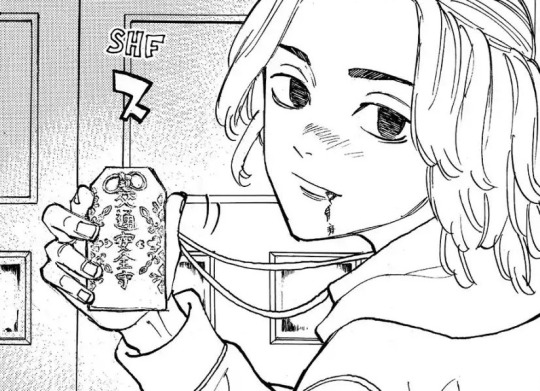
I feel it's important to add up all these little factors of Mikey's choosing, with other little details about him as a person that kinda make it all make sense.
If I say "Mikey seems to be religious, to an extent", I understand this can carry a bunch of tricky connotations. Japanese religion isn't exercised the same way it is in other places, someone being religious SURE AS HECK doesn't mean the same things it means in the christian west. Shinto-buddhism is so commonplace in Japan, most people partake in all kinds of religious practices without even thinking of them as strictly religious, such as new year's celebrations, casual prayer during shrine visits, purchasing and giving charms and such. Religion is integrated in life in a lot of extremely chill ways.
And we can observe a lot of things about Mikey that put him quite above the average in terms of his relationship with local tradition and religion. His house is a huge traditional-style family home, his family is hinted to be active in religious practice (remember Emma's appearances during the Christmas Showdown arc? How she mentioned that their family does a lot of temple visits, and even she considered it weird at that time of the year?), he's much more prone to wearing traditional clothing than his peers, his motif in extra clothing designs is the lion-dog (temple guardians; statues of these can often be found in them), his personal beliefs around death and relationship to the dead run deeper than others' to the point they find him disturbing when he talks about Shinichiro or Baji still being with him... many little things that aren't that deep on their own, of course, but when added up they paint a pretty coherent picture of the guy.
And so, it does make a lot of sense that, even from childhood, a temple was a regular place for Mikey to hang out with his friends, leading to the birth of Toman in one. And it makes a lot of sense that he made all those little choices about the way the gang would be styled. In my opinion, it's likely that those things just all came natural to him because they're a part of his background and worldview. Of course, how actively religious he is, how much he believes in the things he happens to know and how much exactly he might know about buddhism are all up to headcanoning and interpretation. Personally, I'm just a roleplayer that takes it as a relevant part of his character.
- Following a Buddha?
A little out-of-TR-universe element that I love to bring up, 'cause it's just hilarious and cool as hell, is the creation of this statue:
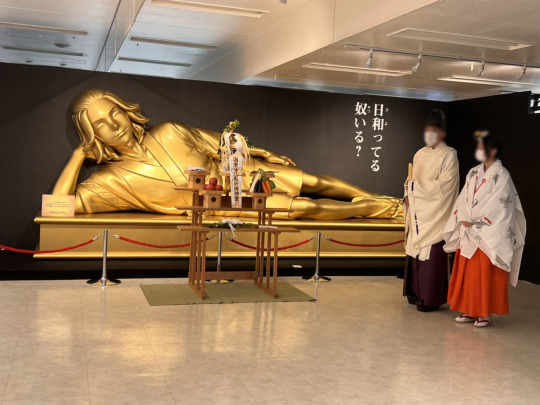
This part of the 2022 Tokyo Revengers exhibition straight up imitates the famous Reclining Buddha in the Wat Pho temple, Thailand.

The ENORMOUS statue depicts the moment Buddha reaches nirvana, and his enlightened soul is at rest. The golden Mikey statue that imitates it very much intentionally likens him to a Buddha; funny to note that the exhibition staff even prayed to the statue, as you can read in the tweet itself.
What does this mean about Mikey's character? Well, this isn't within text in Tokyo Revengers, just a little outside factor, so I wouldn't take it too literally or too seriously, but it's interesting nonetheless. Personally, I see it as a hint that Mikey was supposed to be on his own little quest to enlightenment, or had the potential to be. Grappling with morality without having a natural sense of what's right, wrong, too much or enough is a major thing with his character. I can also imagine it might just be meant to represent the godlike view others have of him, the guidance they sought from him. Take it as you will!
The important thing is just that it exists, to confirm that there is an intentional connection of some type between the Buddha and Mikey.
Thaaaaat concludes the Toman and Buddhism section of this post.
Whew!! That was a whole lot.
The Tenjiku and Taoism section coming now is shorter, but I'm sure it contains interesting and less-known things (at least, I've never seen anybody talk about these)!
So let's see, Tao references in Tenjiku:

- Gang name.
Tenjiku is a now-obsolete word that translated directly to "heaven", while simultaneously being the japanese word for the country India (as taken from the chinese pronunciation, Tianzhu).
In modern times, it can be found mostly in ancient literature, the most prominent example being Journey to the West. Given that Kakucho and Izana mentioned this book and seemed to have knowledge of it as kids, we can conclude that's where they got the name of their gang from.
Why would they use the word for India to name their kingdom? What does this have to do with Tao? I'll get into that properly now:
- Kakucho, Izana & Journey to the West.

Journey to the West is one of the four great chinese classic novels (along with Romance of the Three Kingdoms, Outlaws of the Marsh, and Dream of the Red Chamber) which are enormous, ENORMOUS influences on east-asian literature and fiction in general. Journey to the West, itself, is considered the most popular east-asian literary work overall; of course, being super well-known in Japan, too. (To give my favorite funny example of just how omnipresent it is, y'know Dragon Ball? Hit anime series Dragon Ball? Unabashedly based on Journey to the West, which was to thank for most of its initial local popularity.)
It's the story of the buddhist monk Tang Sanzang, who travels to Tenjiku, to India, to that certain heavenly kingdom, to obtain sacred texts for Buddha Gautama Siddharta (the guy I described as THE Buddha in the Tokyo Manji Gang section above). The quest doubles as a search and exercise of enlightenment, as Tang Sanzang is aided by three protectors that are atoning for their sins and learning from him. The main guardian and arguably the true protagonist of the book is Sun Wukong, the Monkey King, a fighter "so strong he could carry a mountain on each shoulder, and still dash as fast as a meteor". It's a huge, epic, 100-chapter monster of a book, in which each chapter is already a fantastic and entertaining anecdote about the characters or what happens in their travels, but also a long spiritual journey that pretty much serves to subtly teach the principles of Tao (term that can be translated to "the path", chinese religion and philosophy).
A tangent: let me just show you how large it is (and why I haven't been able to finish it, 'cause I cannot take this brick of a book anywhere lmaoooo).

(Cover says Journey to the West: The Adventures of the Monkey King. It's in spanish.)
My guess is that Izana and Kakucho studied about it or read some chapters in school, 'cause dang, there's no way they read all of this at that age?!?! BUT ANYWAY.
While there's obviously quite some buddhist influence in the story, most of what it works with throughout is rooted in chinese folklore and Taoism. The edition of the book I have even begins with extensive notes and introductory explanations about Tao, as its themes of harmony with the universe, self-cultivation, internal alchemy, its main ethics and values, etc etc etc are the basis from which the book is built up. The characters very actively engage with Tao. Sun Wukong is an ardent student of Tao who obtains a bunch of powers through it, for one.
I've gone into this much into detail because Kakucho and Izana make it pretty explicit that, to them, Izana is like monk Tang Sanzang leading to Tenjiku, and Kakucho is like his guardian of unmatched strength, Sun Wukong.
In the end of Journey to the West, it's both Tang Sanzang and Sun Wukong that accomplish their goal and also obtain enlightenment, finally ascending to buddhahood. Had Izana and Kakucho's journey with Tenjiku reached their original destination (not "to become a criminal syndicate that controls Japan" but "to build a kingdom where everyone without a home could exist"), had it been like Tang Sanzang and Sun Wukong's pilgrimage… they would've learned true balance and they would've found the necessary enlightenment.
Again, I find this little connection with characters that could've been on a quest towards buddhahood, but as far as things went in the main TR timelines, all failed.
- Uniform & logo.
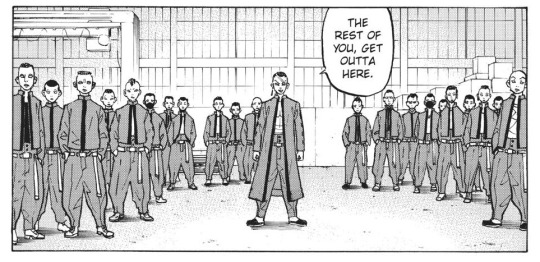
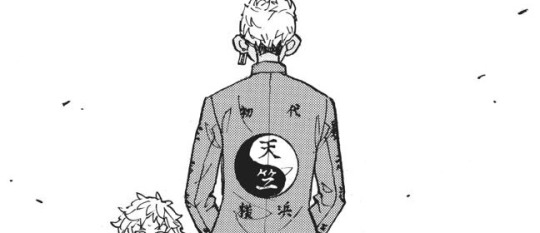
Finally, something lighter and quicker to add, haha.
There are symbols and references that are so so so widespread that they become more of an aesthetic detail than a symbol with meaning, in the eyes of the general public. The yin-yang is one of those symbols that just… appears in a lot of places, fashionably, and one kinda gets used to seeing it without thinking much about it. Sometimes it's not meant to stand for much more than a decorative detail, yes, that definitely happens, but sometimes it's very much a thoughtful choice. With Tenjiku, given its connection to Taoism, I'm gonna treat the yin-yang as a meaningful choice.
So! On the back of the uniform we have a yin-yang, Taoist symbol that represents the balance of the two complementary and opposing forces of the universe (note: it's not a good vs evil type of thing, as tends to happen with western black-white dualism, but rather… the fact that reality needs to be composed of push and pull to get anywhere, hard and soft things with their own function, sun and shade. A common comparison is how a mountain will have a sunny side and a shady side when looked at in a certain moment, but the sun and shade will switch over at another time of day, in a needed cycle). Other features of the uniform are a mao collar instead of a more common style for gang jackets, and an intense red color, the main auspicious and prosperous color in chinese culture. These last two little features could easily be coincidental, but when paired with the yin-yang, I feel like it's intended to lean towards chinese aesthetics.
And with that,
I end this reference post!
Did you learn anything you didn't know? Did you enjoy learning it? Any thoughts? I LOVE TO TALK ABOUT THESE THINGS, SO FEEL FREE TO DROP BY MY ASKBOX with any comments or questions or such!!
#tokyo revengers#tokyo revengers meta#tokyo manji gang#toman#tenjiku#kurokawa izana#sano manjiro#izana kurokawa#manjiro sano#mikey#kakucho#thoughts and talk and so#tokyo rev#wanted to write this one forever#just never quite got around to it
206 notes
·
View notes
Text

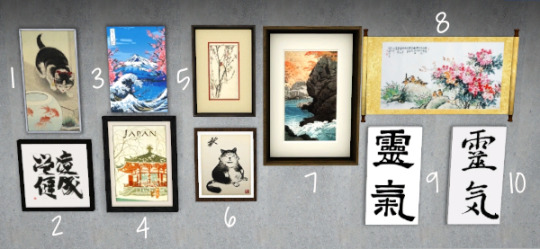
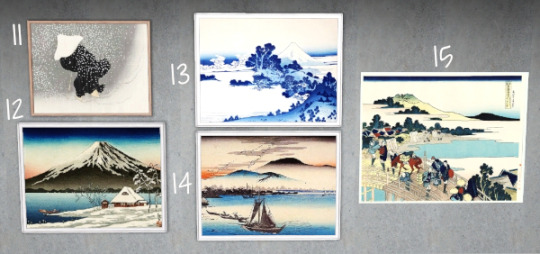
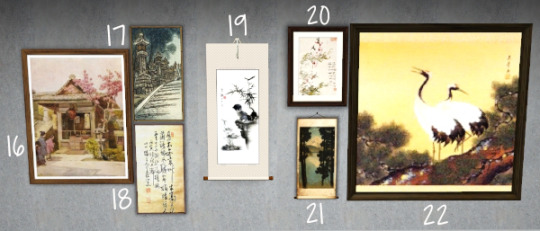
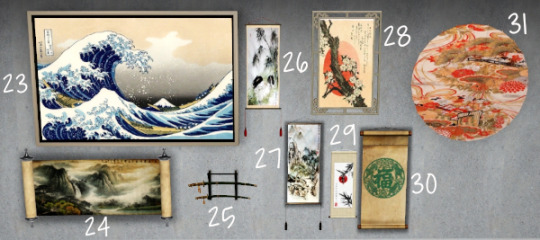
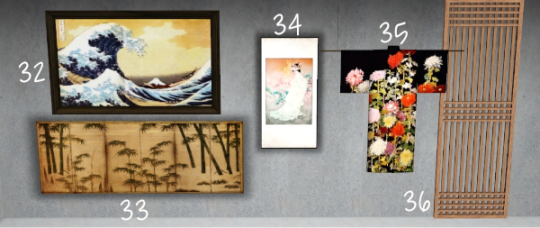
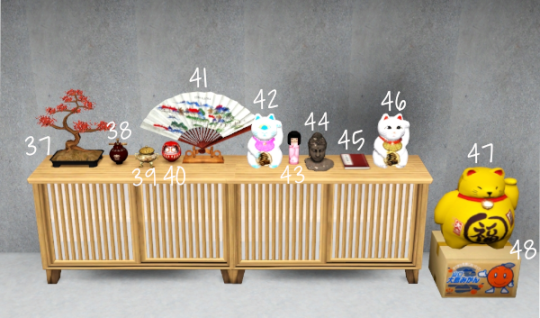
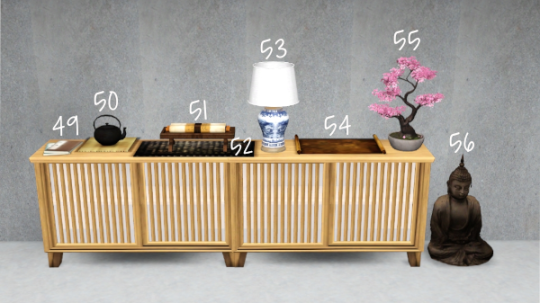

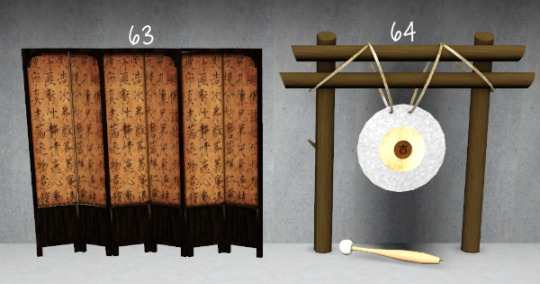
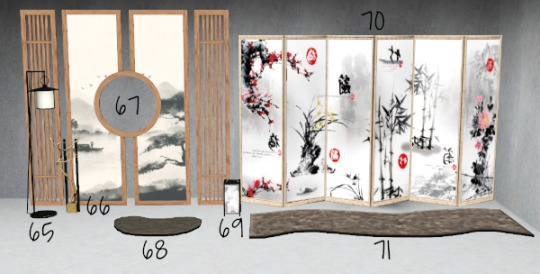
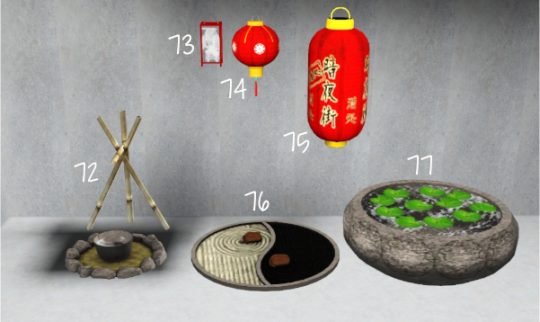
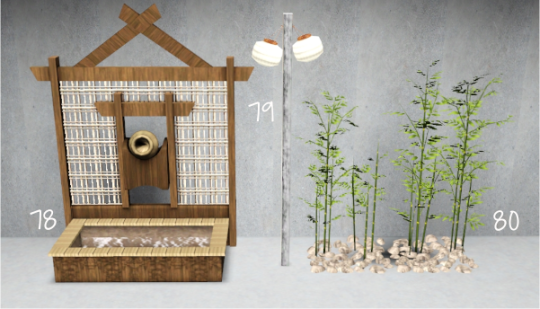
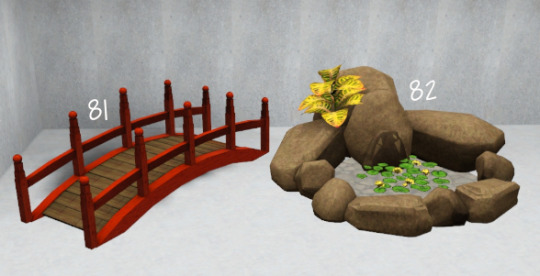
WanderingSims Fave CC - Traditional Asian Décor List
1 - simbalances - Ohara Koson Prints
2 - ziggy28 - Virtue Asian Character Paintings (TSR)
3 - WanderingSims - Japan Wall Art
4 - chuchuwitch - Asian Paintings
5 - baufive - Flock of Woodcuts
6 - BionicZombie - 4t3 Snowy Escape Paintings
7 - baufive - Japanese Woodcuts
8 - LCC - Chinese Scroll Claborate Style Painting
9 - Devirose - Japanese Ideograms 1 (TSR)
10 - Devirose - Japanese Ideograms 2 (TSR)
11 - Devirose - Japanese Prints Collection (TSR)
12 - Devirose - Japanese Print 1 (TSR)
13 - Devirose - Japanese Print 2 (TSR)
14 - Devirose - Japanese Print 3 (TSR)
15 - Devirose - Japanese Art Collection 2 (TSR)
16 - ziggy28 - Japanese Scenes (TSR)
17 - Devirose - Japanese Art Collection 3 (TSR)
18 - Devirose - Japanese Manuscript (TSR)
19 - ziggy28 - Large Asian Cats Scroll (TSR)
20 - linasometimes - Wisteria & Blossom Paintings (TSR)
21, 25, 33, 37 - you-lust - Vaguely Japanese Pt. 1 Set (Eastern Blossoms Scroll, Blades of Masamune Wall, Japanese Cantankerous Splatter Painting, Zen Bonsai)
22, 32 - Kilhian - Japanese Painting Birds & Sea
23 - ohymysims - Painting Katsushika Hokusai
24, 27, 39-40, 52, 61 - you-lust - Vaguely Chinese Pt. 2 Set (Huabanzhu Chinese Scroll, Yuxi Winter Blossoms Scroll, MTSims Chinese Burner, The Daruma Wishing Doll, Yuxi Bamboo Slip, Shoyou Shoji Screen)
26 - MurfeeL - Wall Scrolls w/Tassels
28, 41, 70 - MurfeeL - Birthday 2020 Dump (EA WA EP Vintage Chinese Ads Framed, AMR Fan Decor Redone, Lacquer Byobu Decor)
29 - Living Dead Girl - Benjamin Bedroom Artwork Asian (TSR)
30, 38, 51, 54, 63 - you-lust - Vaguely Chinese Pt. 1 Set (Yuxi Tokonoma Series Scroll, The Little Jug of Wishes, Yuxi Dragon Scroll, Yuxi Scroll Clutter, Yuxi Ixinqin Screen)
31 - RD - From The East Wall Art
34-35, 50 - you-lust - Vaguely Japanese Pt. 2 Set (Yuxi Haruyo Morita Painting, BBSL Hanging Kimono, WFS Teapot)
36, 65-67 - KerriganHouseDesigns - Hayashi Set (Wallpanel, Floor Lamp, Golden Branch, Screen)
42-43 - you-lust - Azaya Fortune Cat & Higanbana Kokeshi Doll
44 - Martassimsbook - 4t3 novvvas Desierto Bedroom Buddha
45 - MurfeeL - Yokai E-Hon Books as Decor
46-47 - Ritsuka - Fortunate Cat & Japanese Lucky Cat
48 - Ziva-Sims - SimpleStudio404 Japanese Box Recs
49 - MurfeeL - MTCakestore Chinese Books Stackable
53 - HydrangeaChainsaw - Antique Set Chinese Table Lamp
55 - HydrangeaChainsaw - Sakura Bonsai
56 - you-lust - lisen-nymphy Buddha
57 - NoirandDarkSims - Mitarsi Kitsune
58 - SimpleStudio404 - Japanese Misc Set Emongake Deco
59 - you-lust - simaddict99 Oriental Paper Parasol
60, 68, 71-72, 76-77, 81-82 - TheNumbersWoman - Going Asian Outdoor Garden Set (Pagoda, Rock Path 2, Rock Path 1, Fountain, Ying Yang Garden, Water Feature, Deco Bridge Large, Apris Rocks Ponds) (TSR)
62 - Devirose - Japan Rug 1 (TSR)
64 - Angela - Kanto Garden Gong (TSR)
69, 73-75 - MurfeeL - C2077 Dashi no Matsuri Set (Parade Square Table Light, Parade Square Ceiling Light, Parade Round Ceiling Light, Parade Oval Ceiling Light)
78 - SIMCredible! - Asian Nook Fountain (TSR)
79 - DOT - Yard Wire Pole Lantern Mesh (TSR)
80 - SIMCredible! - Momentum Bamboo (TSR)
351 notes
·
View notes
Note
Forgotten Queen Medusa as she not human anymore even in Valhalla with her children the one thing she really misses is to sing as before she sings for the lesser deities as thanks for providing not also clean water and things they provide, but also the effort they give to protect the people she used to rule over
And now her voice as she sing sounds like a Timat from FATE and Biollante from the Godzilla Kaijus moxed together
Beautiful yet whenever she sings it forever make herself and anyone around her forever hear that she is in pain not just physically but her soul is in pain all because what have happened to her and what punishment that she receive unjustly
How would Zero, Heracles, Thor, and Tesla when they hear her sing when she thinks she is alone
-You were not the type of person to cry when you are feeling sad or lonely- you were raised as a queen, and a queen symbolizes strength and crying was deemed a weakness in your time.
-When you would feel sad, when the tears would well in your eyes, threatening to spill, you would wander off, find a quiet place, and sing.
-Your voice was beautiful, but also haunting- alluring, many thought you were a siren, because when you sang, everyone stopped and listened, those who were nearby to hear you.
-In Valhalla it was no different, while you weren’t hunted and treated like a monster, there were times where you would get sad, mourning your children- those who didn’t ascend with you, so, just like before, you would sneak away and just sing any song that you knew of.
-It had been better here recently, humanity won in Ragnarok, and you became the mother figure of Zerofuku whom you adored, but you couldn’t help but think about your children- your husband, all those that you have loved and lost.
-You were able to sneak away as Zerofuku went to go visit Buddha- giving you some alone time, and you went into your quiet garden, sitting near a large fountain in the center.
-You looked up at the sky before you closed your eyes, inhaling deeply before you began to sing.
-The tune was haunting, in the way that sadness seemed to surround you, hanging heavily in the air around you.
-You were unaware of your audience, a single person, who had seen you and went to call out when you started to sing and instantly he was like a statue, frozen in place, eyes wide, listening to you.
-He could feel sadness, your sadness, entering his own heart, making his tears well but not fall, it was like he could feel how you were feeling at the moment.
-You were always so strong, you always held your head high- to see you like this- to feel you like this, it was breathtaking but also heartbreaking.
-Zerofuku- His loud sniffle interrupted you and you quickly turned, your eyes going wide as he was crying, large crocodile tears flowing down his face before he began to sob, rushing over to you, into your open arms. You smiled sadly, hugging him close, squeezing him as he sobbed into your chest, your snakes peppering him with soft kisses, trying to calm him down. He sniffled, looking up at you, “Did-did I do something bad to make you so sad?” you smiled softly, brushing your hands along his cheeks, trying to brush his tears away, “No darling, you didn’t do anything. Every now and then I will do this- to let my emotions out.” He looked a bit confused before he buried his face back into your chest, hugging you close, and you heard his promise, muffled, which made you grin, that he was going to make you extra happy.
-Hercules- If it were anyone else, you would have leapt when he put his hand on your shoulder, but your babies, your snakes, alerted him to you while you were still singing and you didn’t care- you knew Hercules was a good person. You turned your head, your song dying out and looked up into his large, worried eyes, ones that had recently shed tears, “Y/N? Are-are you okay?” you smiled softly, patting the fountain rim where you had been sitting, “I will be- I just needed to express myself for a moment.” Hercules was worried before his hand wrapped around your shoulders, pulling you into a small hug, “You can cry if you want to, Y/N. It’s not good to hold all that sadness inside you.” You said nothing but smiled, leaning into his hug with a small sigh of content- he was so sweet.
-Thor- He never let his tears fall even though they wanted to, your sadness seemed to… resonate with him, he knew what you were doing, as he did it often as well, only he would go out and break stuff or look for someone to fight. As your song died he remained on the other side of the fountain, as he had chosen not to bother you- as when he got like this he didn’t want to be bothered. Thor forgot about your snakes as you called out, “Are you going to come over- or are you just gonna stand over there and stare?” Thor flinched and he came over, seeing you smiling up at him softly before your snakes stretched out to say hello. He was gentle, lifting his hand to let them wrap around it, “I forgot about these- you’ve got eyes everywhere.” You smiled softly before you leaned your head on his shoulder, “I’m glad you’re here Thor.” He was silent, but did nothing to move you, he was glad to be there for you- to make you just a bit happier.
-Nikola- Sobbing filled your ears and you turned, your song dying as Nikola ran over, immediately hugging you and you squealed, “Wait Nikola!” SPLASH!! He was quick to sit up, pulling you with him, “I’m so sorry Y/N! I didn’t mean to get us both wet, I just wanted to comfort you!” If you had any annoyance for his actions, they were quickly gone as you gave him a small smile, “You’re so sweet- as always, Nikola.” His cheeks turned a bit red before he grinned, standing up before stepping out and he turned to help you out. You reached up, brushing the tears from his cheeks, “You cheered me up, but as punishment for getting me wet, will you walk me home?” he instantly offered you his arm, seeing that you weren’t upset with him in the slightest, smiling down at you, “I’m glad that I was able to help!” you hugged his arm close, making his cheeks warm with color, he really was a sweet-pea.
62 notes
·
View notes